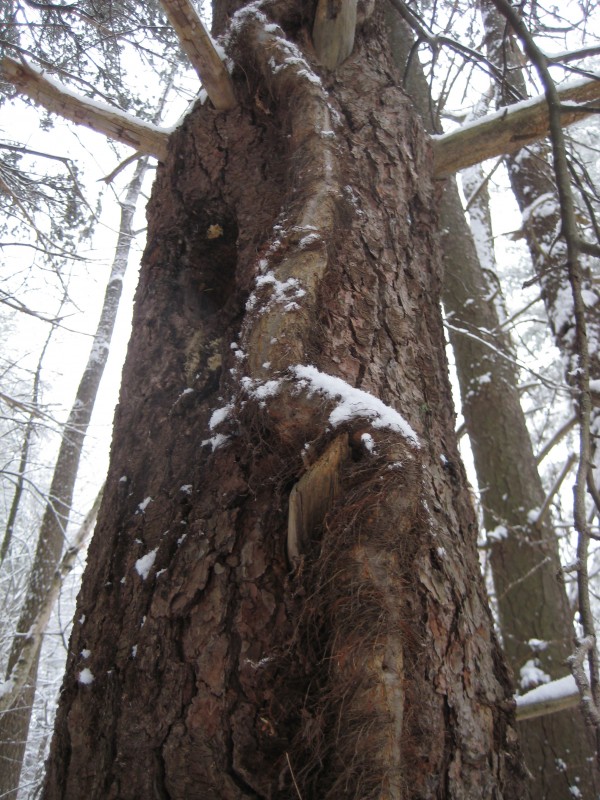“For many years I was a self-appointed inspector of snowstorms and rainstorms and did my duty faithfully, though I never received payment for it.”
Henry David Thoreau

You have to love Thoreau. He’s so quotable. And so energetic—no armchair nature lover, this guy. He went out almost every day for a four-hour stroll.
I admit that most of my snowstorm inspections are done through a window. But the other day I was at Pine Hollow Arboretum in Slingerlands, NY, strolling through the trees as the snow was softly falling. There’s something about snow that outlines the most beautiful essentials of nature: the strong branches of the pines, the graceful silhouettes of the spruces and cedars. And the long, hairy ropes of poison ivy.
Here’s some truly majestic poison ivy. The big vines have aerial rootlets, which give them that furry look—the rootlets absorb oxygen and also help the vine adhere to the trunk like glue, climbing high into the branches.
Poison ivy climbing up the trees. This is a good thing.
No, I haven’t lost my sanity. First of all, PI vines don’t kill trees the way some other species do. All throughout the Northeast, trees are being destroyed by Oriental bittersweet vines, which corkscrew around trunks and eventually strangle the tree. Poison ivy tends to go straight up the side of the tree. It may shade out some of its host’s leaves, but PI rarely impacts the host tree severely.
But the best thing about poison ivy is this: birds love it.
In the fall, birds tend not to eat poison ivy much. (Not because of the itch factor, which doesn’t affect them.) PI berries are low in lipids, which are molecules that contain fats and vitamins. Lipids are gold for birds that are migrating–if you’re going to fly a couple of thousand miles, fatty foods are crucial stored energy, like gas in the tank for a long drive.
So fall migrants skip the PI and focus more on eating berries with higher lipid concentrations: dogwood berries, for instance. This means that the bulk of the PI berries are still there when the migrating flocks depart. And who feeds on these tasty and nutritious leftovers?
The stay-at-homes. The local guys. The ones who don’t fly south to the Florida condo. Cardinals. Mockingbirds. Chickadees. Wild turkeys. Robins. Bluebirds. White-throated sparrows. Tree sparrows. And especially woodpeckers: downy woodpecker, hairy woodpecker, pileated woodpecker, Northern flicker, and red-bellied woodpecker.
A study by the U.S. Fish and Wildlife Service, based on analyses of stomach and crop contents, listed more than sixty species of songbirds and seven species of mammals that feed on poison ivy. The results of this study were published in a classic reference book for biologists, American Wildlife and Plants: A Guide to Wildlife Food Habits. It says that poison ivy berries can comprise 25% of the food of some types of woodpeckers in fall and winter.
Poison ivy is a good thing. It’s a component of excellent wildlife habitat, provides crucial shade for amphibians, prevents soil erosion and –what? What’s that you say?
One little drawback to poison ivy? Something about an itchy rash?
Ah, yes. In my enthusiasm for the unloved plants of the world, I must not forget that poison ivy can pose a very real threat to people who are allergic to it. I know, I am one.
Sadly, I am not among the 15% of the human population that is immune. I have scratched many an itchy, blistering rash.
Poison ivy should obviously be controlled, by organic methods. It’s wise to cut poison ivy back, as they do here at Pine Hollow, or cover it with mulch or black plastic, when it grows near trails, benches, railings, and picnic tables.
But in the back woods, high up in the trees, poison ivy is a furry and life-giving bird feeder.
Itching to know more? Check out my books:
In Praise of Poison Ivy: The Secret Virtues, Astonishing History, and Dangerous Lore of the World’s Most Hated Plant. Identification, tips for healing the itch, and why birds love PI–everything (and more) that you ever wanted to know about poison ivy.
Leaflets Three, Let It Be! A picture book for pre-K to Grade 3, to help the youngest explorers enjoy nature safely.





Recent Comments